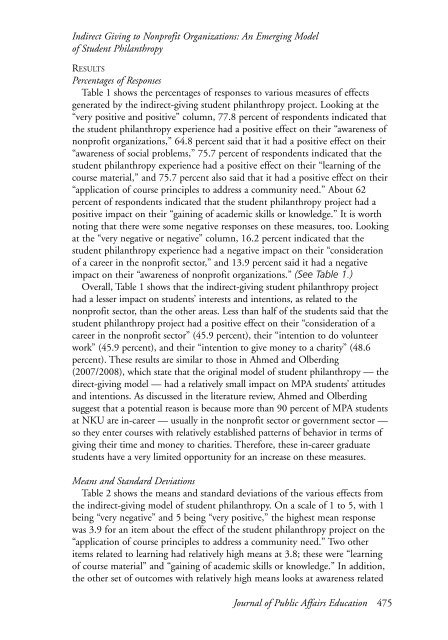JOURNAL OF PUBLIC AFFAIRS EDUCATION - National ...
JOURNAL OF PUBLIC AFFAIRS EDUCATION - National ...
JOURNAL OF PUBLIC AFFAIRS EDUCATION - National ...
Create successful ePaper yourself
Turn your PDF publications into a flip-book with our unique Google optimized e-Paper software.
Indirect Giving to Nonprofit Organizations: An Emerging Model<br />
of Student Philanthropy<br />
RESULTS<br />
Percentages of Responses<br />
Table 1 shows the percentages of responses to various measures of effects<br />
generated by the indirect-giving student philanthropy project. Looking at the<br />
“very positive and positive” column, 77.8 percent of respondents indicated that<br />
the student philanthropy experience had a positive effect on their “awareness of<br />
nonprofit organizations,” 64.8 percent said that it had a positive effect on their<br />
“awareness of social problems,” 75.7 percent of respondents indicated that the<br />
student philanthropy experience had a positive effect on their “learning of the<br />
course material,” and 75.7 percent also said that it had a positive effect on their<br />
“application of course principles to address a community need.” About 62<br />
percent of respondents indicated that the student philanthropy project had a<br />
positive impact on their “gaining of academic skills or knowledge.” It is worth<br />
noting that there were some negative responses on these measures, too. Looking<br />
at the “very negative or negative” column, 16.2 percent indicated that the<br />
student philanthropy experience had a negative impact on their “consideration<br />
of a career in the nonprofit sector,” and 13.9 percent said it had a negative<br />
impact on their “awareness of nonprofit organizations.” (See Table 1.)<br />
Overall, Table 1 shows that the indirect-giving student philanthropy project<br />
had a lesser impact on students’ interests and intentions, as related to the<br />
nonprofit sector, than the other areas. Less than half of the students said that the<br />
student philanthropy project had a positive effect on their “consideration of a<br />
career in the nonprofit sector” (45.9 percent), their “intention to do volunteer<br />
work” (45.9 percent), and their “intention to give money to a charity” (48.6<br />
percent). These results are similar to those in Ahmed and Olberding<br />
(2007/2008), which state that the original model of student philanthropy — the<br />
direct-giving model — had a relatively small impact on MPA students’ attitudes<br />
and intentions. As discussed in the literature review, Ahmed and Olberding<br />
suggest that a potential reason is because more than 90 percent of MPA students<br />
at NKU are in-career — usually in the nonprofit sector or government sector —<br />
so they enter courses with relatively established patterns of behavior in terms of<br />
giving their time and money to charities. Therefore, these in-career graduate<br />
students have a very limited opportunity for an increase on these measures.<br />
Means and Standard Deviations<br />
Table 2 shows the means and standard deviations of the various effects from<br />
the indirect-giving model of student philanthropy. On a scale of 1 to 5, with 1<br />
being “very negative” and 5 being “very positive,” the highest mean response<br />
was 3.9 for an item about the effect of the student philanthropy project on the<br />
“application of course principles to address a community need.” Two other<br />
items related to learning had relatively high means at 3.8; these were “learning<br />
of course material” and “gaining of academic skills or knowledge.” In addition,<br />
the other set of outcomes with relatively high means looks at awareness related<br />
Journal of Public Affairs Education 475

















